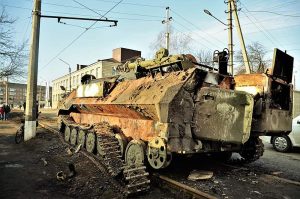As Russia’s war in Ukraine intensifies and brings ever-more grievous harm to Ukrainian civilians, there have been increasingly strident calls from both the Ukrainian government and some Western commentators and politicians for direct NATO involvement. Many of the calls have coalesced around the establishment of a no-fly zone (NFZ) over Ukrainian territory, with the idea that cutting off Russian air support would blunt the offensive and potentially force Russia to accept a ceasefire.
Unfortunately, the concept is fundamentally flawed, at least in this situation. The reason can be found within the logic of escalation, with potential ramifications for other possible great power conflicts, not least in Asia.
An NFZ cannot simply be declared; an unenforced zone would be a blow to NATO credibility without providing any meaningful benefit. And enforcement would axiomatically mean war against Russia. NATO jets cannot enforce an NFZ while threatened by Russian air defenses, many of which – like the S-400 Triumf – can engage targets from comfortably within Russian or Belarusian territory. Those systems would need to be destroyed to make combat air patrols feasible. But that, in turn, would require NATO to kill Russian servicemen on Russian and Belarusian soil, with a high probability of civilian casualties as well.
Nor do the problems stop there. The Russian air force has played a surprisingly limited role in the conflict thus far. While a more active Russian aerial presence might improve the tactical outcomes for their forces on the ground, the real threat to the civilian population of Ukraine comes primarily from massed Russian artillery. If NATO took the mission of safeguarding Ukrainians upon itself, a no-fly zone would turn into a no-drive zone very quickly (as it did in Libya, the last time the concept was applied).
That state of affairs would not immediately lead to nuclear warfare. But the problem with warfare between nuclear-armed states is that once escalation begins, it becomes harder and harder to step down. Herman Kahn described escalation as a ladder, but the analogy is flawed – climbing the first step of a ladder isn’t noticeably easier or harder than climbing the last. Escalation might be better understood as a slide: The farther down you go, the more difficult it is to bring yourself to a stop.
A direct NATO intervention would open the door to Russian conventional retaliation. Those could include highly disruptive but nonlethal options, such as cutting subsea telecoms lines, blowing up U.S. satellites with anti-satellite weapons, or massive hacking against infrastructure targets across Europe and the United States.
With his own dead stacking up even faster than they already are, Putin might be more inclined to seek like-for-like revenge. His tools for doing so are legion. Russia’s strategic bomber force could be used to launch conventional airstrikes against NATO targets in Europe or farther afield. The Russian Navy maintains a large and capable submarine fleet, which could be ordered to attack NATO warships. And unconventional warfare units might undertake sabotage operations behind NATO lines. (One upshot of the battle for Ukraine is that an armored thrust into central Europe – the animating focus of NATO’s strategy during the Cold War – is unlikely for the immediate future, given that the bulk of Russia’s deployable land forces are bogged down fighting the Ukrainians.)
At the point where two nuclear-armed combatants are fighting each other directly, the slide becomes far harder to stop. Taking losses creates both political and strategic incentives to retaliate and bring the war back into parity. Furthermore, if the leadership of one side perceives itself as being in danger of not only losing the war but losing its grip on the levers of power – or their very lives – their risk calculus changes fundamentally. From their perspective at that stage, the use of nuclear weapons may seem less like an insane, suicidal escalation and more like a last-ditch attempt to stave off utter military defeat and/or a palace coup or popular uprising.
The problem is only exacerbated in situations where the power imbalance is more severe. North Korea, for example, does not have a survivable second-strike capability and its conventional forces are far more brittle than Russia’s. In the event of a shooting war, the barrier to the North Koreans using nuclear weapons – either in theater or against U.S. targets in the Pacific or even on North American soil – would be significantly lower. By contrast, the odds of nuclear escalation with China up until now have been relatively low, given China’s strategic depth and its relatively modest (though survivable and capable) nuclear arsenal – though its recent moves toward greater capability open the door to a range of potentially escalatory scenarios.
Nevertheless, the current crisis should remind us of the dangers that we have been living with since 1945 have never truly gone away, while some of the mechanisms that delivered us to the end of the Cold War in relative peace and safety have. Building and sustaining mechanisms by which nuclear-armed opponents can clearly signal intents and limitations to each other even in the midst of extremely sharp geopolitical conflicts is key to ensuring things don’t get far, far worse.

































